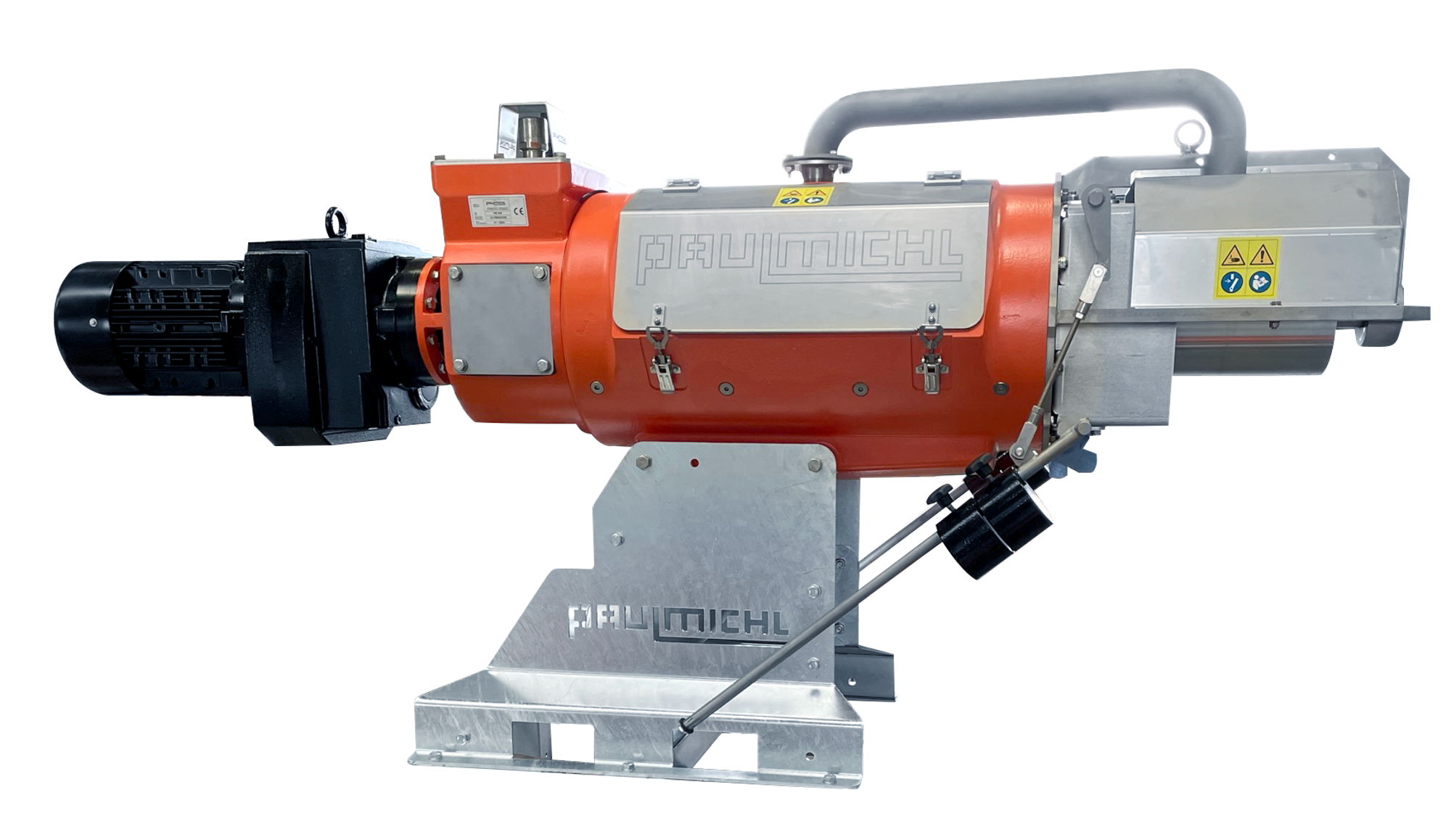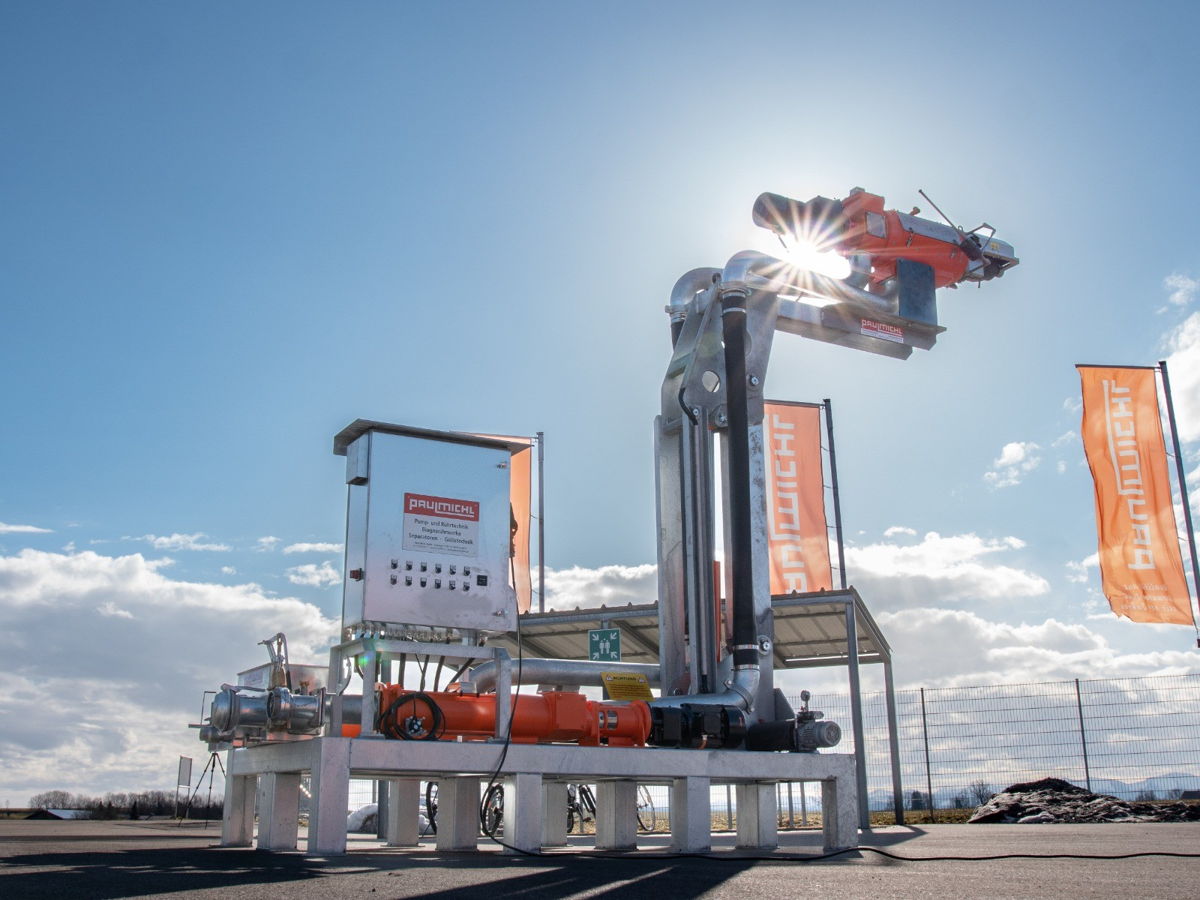Technical data
- Extensive special technical equipment
- Standard press screw with counter bearing and special wear protection
- Ideal for large farms & contractors
- Robust cast housing
- Gear motor 5.5 / 7.5 kW
- Flow rate up to 65m³/h (depending on the medium to be separated)
- DM content up to 32 %
Mobile & stationary separators
Each basic model (the PM 200, PM 260, PM 300, PM 300x press screw separator) can be built in different versions and thus completely customised to the specific conditions. It is possible to configure the separator as a stationary or mobile unit with our models & superstructures.
Mobile models & superstructures
Why compact?
|
Description of the unit The unit is built on a robust hot-dip galvanised base frame and can be positioned accordingly using a lifting vehicle. All components are integrated into the compact base frame and guarantee very good accessibility. The fully automatic control and regulation unit enables reliable separation operation of the system. With a frequency converter installed as standard, the separator can be fed via manual individual speed control and pressure control technology. Thanks to its compact design, the separator can be set up in just a few minutes. The separator is fed via a self-priming progressive cavity pump. The press water is discharged via a free drain. An additional press water pump can be fitted as an option. The pump is equipped with a vacuum, temperature and leakage sensor as a safety device. |
Why split?
- Separator and feed pump each on a separate frame
- Separator can be positioned on an elevation (e.g. platform, wall or Lego brick) - larger discharge area
- Discharge of the solids takes place at a fixed location
- The separator can be fed with the pump from different pits
Description
Separate from a height. The feed pump and the separator are each an independent component in their own right. This has the advantage that the separator can be mounted on an elevation such as a platform. The suction path can be kept as short as possible thanks to the flexibly positionable pump. The pump is equipped with a vacuum, temperature and leakage sensor as a safety device.
Why Hydro?
- Entire unit can be transported and positioned using a lifting vehicle
- Discharge height over 4 m
- Direct substrate discharge into a transport vehicle
- Unit mounted on a robust, hot-dip galvanised base frame
- Possible variants: Hydro A or Hydro F for easy transport by car or tractor
Description of the unit
Set up, drive up & get started. The Hydro separator is a professional model for mobile separation. The hydraulic lifting device on the separator enables direct separation from the substrate into a high trailer or transport vehicle. This saves you money on expensive superstructures or time for loading into a trailer. You also have the flexibility to use the separator on any system.
The separator is fed via a self-priming progressive cavity pump. Depending on the model variant, the unit has a throughput capacity of up to 85 m³/h. The fully automatic control and regulation unit enables reliable separation operation of the system. With a frequency converter installed as standard, the separator can be fed via manual individual speed control and pressure control technology. The pump is monitored with a vacuum, temperature and leakage monitor for safety. The press water is discharged via a free outlet or a press water pump.
Hydro A variant: A variant of the Hydro separator is the Hydro-A. Here, the separator is permanently installed on a car trailer, making transport even easier. The separator can be attached and transported immediately without the need for lengthy loading and lashing. Thanks to a total weight of max. 3.5 t, a class BE trailer driving licence is sufficient. With various attachment options, feed and press water hoses and various couplings can be attached directly to the chassis, making operation even easier. Of course, the Hydro-A is road-legal and is therefore also ideal for inter-company use.
Variant F: The Hydro-F is the big brother of the Hydro-A. It takes up the advantages of the Hydro-A, with the difference that it is installed on an agricultural chassis and is therefore transported with a tractor. One of the advantages of the Hydro-F is that the fold-out direction is in the direction of the drawbar. This means that it can also be positioned and operated in confined spaces. The drawbar can be retracted and extended and therefore does not interfere with operation. This makes the separator even more flexible to use. As the weight is not limited to 3.5 t here, the trailer can be equipped with even more accessories. With various mounting options, feed and press water hoses as well as various couplings can be attached directly to the chassis and make operation even easier.
Why conveyor belt?
- Swivelling conveyor belt
- All components on a robust, hot-dip galvanised base frame
- Quick assembly & deployment
- Solids discharge directly onto a trailer
Description
Mobile. simple. fast. The mobile separation unit can be safely transported and positioned on a car trailer. It is ready for use in just five minutes. The separator is fed by a self-priming progressive cavity pump. The additional pump conveys the press water reliably and automatically to the desired container. The conveyor belt is 6 metres long.
Why lorry superstructures?
- Unit permanently installed on vehicle
- Very high throughput lines possible (>100 m3/h)
- Customised solution for the respective trailer incl. fully automatic control technology
- Solids discharge by means of conveyor belt/screw conveyor
Description
We can also find a customised solution for special circumstances or requirements. Tell us what you need and where, and we will develop the right separator for you.








